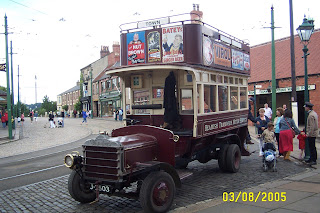I have had little opportunity to explore Co. Durham, but both visits to the county have been taken up solely with Beamish Living Museum. Both times, the visit has taken a whole day, and now, I understand, it's even bigger, with the new addition of a 1950s town, amongst other exhibits. The best thing is, your ticket gives you access for a whole year.
It is so large, that, unless you're extremely fit, you need to avail yourself of the trams and buses to move around the site.
Its inception goes back to 1970 and a gentleman called Frank Atkinson, who realised that the North-East was rapidly losing all its industries, and wanted to preserve them in a way that people - and particularly children - in the future could understand their past.
Now I love living museums, and you will find several on this blog. I believe it's the best way to teach children their social history, they learn without realising they're learning. And while you're there, buy one of their books. It's called Beamish - The Experience Of A Lifetime. It's not just a guide to the museum, but it's a beautifully produced full-colour history of the North-East from the early 1800s to the middle of the 20th. century.
one of the buses that take you around. (all transport is free). It's a replica of a Northern General bus of the time.
The 1900s town, with it's variety of shops, some, like the sweet shop, have goods you can buy. Mind you, there's also a dentist!
The tram picking up passengers at the end of the High Street. It may look as though it's too modern for the town, but don't forget, the vehicles travel around the entire site, so the Northern General bus will look equally out of place in the 1950s town! These are all authentic buildings that have been rescued from demolition elsewhere
At the west end of the town, is a Victorian park, complete with a bandstand that came from Saltwell Park in Gateshead
The 1820s Pockerley wagonway, on which you can take a short ride in an open carriage. and which is in the valley below Pockerley Manor. The invention of the steam locomotive by George Stephenson is well-documented, so no need to relay its history here.
The Great Shed here, is based upon the lost buildings of Shildon works in County Durham, and it incorporates ironwork from George Stephenson's Forth Bank works in Newcastle-upon-Tyne.
However, it turned out to have been built by a now forgotten firm, Hawks & Co. of Gateshead.
Apparently, it had a top speed of a whole 4.5 mph! Once the researchers at Beamish had done their work, the decision was taken to re-construct one, using an oil painting and a couple of other illustrations as their sole source of visual reference, and other contemporary engines as technical sources.
And this one (below) is a fully-working replica of Stephenson's 'Locomotion' - the original being a static display at the Head of Steam Museum in Darlington.
The third engine they have - although I have not seen it yet - is a replica of 'Puffing Billy', again reconstructed from the original museum piece.
In the centre of the site stands the coal mine and the colliery village. The buildings have all been saved from different locations in the North-East, but they are all representative of how every colliery village would have looked, as the Regional Coal Board would have built them all to the same design. Every village would have had its' workers' cottages, a chapel - in this area Methodist, and a Board school, for those children too young to work down the pit.
Below: a row of miner's cottages, rescued from demolition at Francis Street, Hetton-le-Hole, built in the 1860s. The grandmother of a friend once lived in one of them. They are kept exactly as they were. You can go in them and see the housewife preparing food on the kitchen range (the smell is amazing!)
The kitchen garden is at the front of the cottages, and the vegetables grown here, are used in the museum restaurant. Out the back of each cottage is a flagstone yard, with an outside toilet and a small wash-house for the laundry.
These cottages are next to the small mine, that you can take a guided tour around. The rest of the mine village has a chippy, a small school and a chapel. The village is set in the 1900s.
These cottages are next to the small mine, that you can take a guided tour around. The rest of the mine village has a chippy, a small school and a chapel. The village is set in the 1900s.
Flash, the pit pony. They may have been small, but pit ponies were extremely strong, and spent most of their lives hauling really heavy loads of coal from the pit face to the lift shaft
The processing plant at the mine head. At its peak in 1913, the Great Northern Coalfield alone employed nearly a quarter of million men and boys.
There is also a 1940s farm and a 1950s farm, which are real working farms. And a full-size railway. There will shortly be a 1950s town too













No comments:
Post a Comment